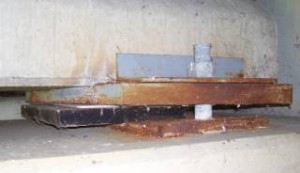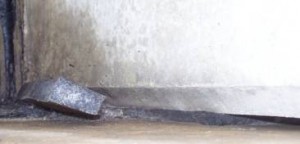Research Problem Statement and Objectives
 Elastomeric bridge bearings are much easier to install in a bridge in comparison to other types of bearings and require minimum maintenance. This type of bearing has been used for decades by the Maryland State Highway Administration (MDSHA) on prestressed or reinforced concrete bridges. Based on manufacturers’ reports, elastomeric bearings should not undergo marked stiffening at low temperatures when the thermal contraction of the bridge deck is at maximum. Such stiffening could be deleterious to the bearing and/or structure. Correctly-designed and installed elastomeric bridge bearings can be confidently expected to function efficiently for at least two decades. However, reports from other states have stated problems of some cases using elastomeric bearings.
Elastomeric bridge bearings are much easier to install in a bridge in comparison to other types of bearings and require minimum maintenance. This type of bearing has been used for decades by the Maryland State Highway Administration (MDSHA) on prestressed or reinforced concrete bridges. Based on manufacturers’ reports, elastomeric bearings should not undergo marked stiffening at low temperatures when the thermal contraction of the bridge deck is at maximum. Such stiffening could be deleterious to the bearing and/or structure. Correctly-designed and installed elastomeric bridge bearings can be confidently expected to function efficiently for at least two decades. However, reports from other states have stated problems of some cases using elastomeric bearings.
 NCHRP Report 449, Test Methods for Elastomeric Bridge Bearings, contains the findings of a study undertaken to develop performance-related specifications for elastomeric bridge bearings. This report will be a good source for obtaining information about the problem,laboratory testing and mathematical analysis associated with type of bearings. The emphasis will be collecting as much field information (structure type, bearing type, size, grade, deformation measurements, degree of delamination, bulging, cracking, etc) as possible to assemble a matrix on deterioration modes versus potential causes. The field information will be supplemented with material acceptance test reports, design method or policy used and bearing details. The variables (some independent some interdependent) that can cause bearing deterioration is large in number therefore much information will have be collected to arrive at most probable causes by bridge.
NCHRP Report 449, Test Methods for Elastomeric Bridge Bearings, contains the findings of a study undertaken to develop performance-related specifications for elastomeric bridge bearings. This report will be a good source for obtaining information about the problem,laboratory testing and mathematical analysis associated with type of bearings. The emphasis will be collecting as much field information (structure type, bearing type, size, grade, deformation measurements, degree of delamination, bulging, cracking, etc) as possible to assemble a matrix on deterioration modes versus potential causes. The field information will be supplemented with material acceptance test reports, design method or policy used and bearing details. The variables (some independent some interdependent) that can cause bearing deterioration is large in number therefore much information will have be collected to arrive at most probable causes by bridge.
Implementation Summary
The proposal is divided into four tasks:
- Identify problematic bridge bearings
- Detect deterioration modes of the elastomeric bearings
- Find the causes of deterioration and categorize them
- Summary and Conclusion